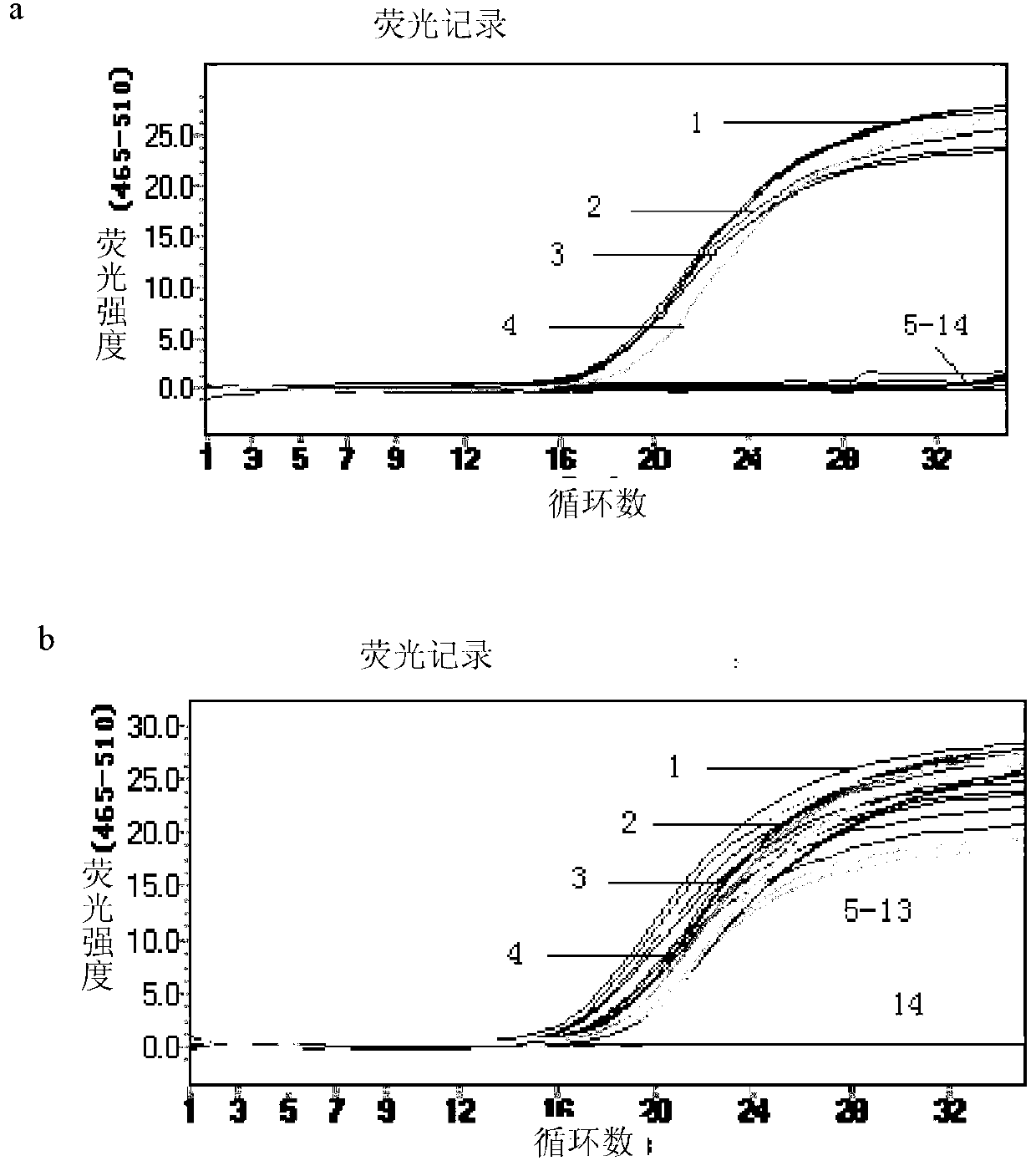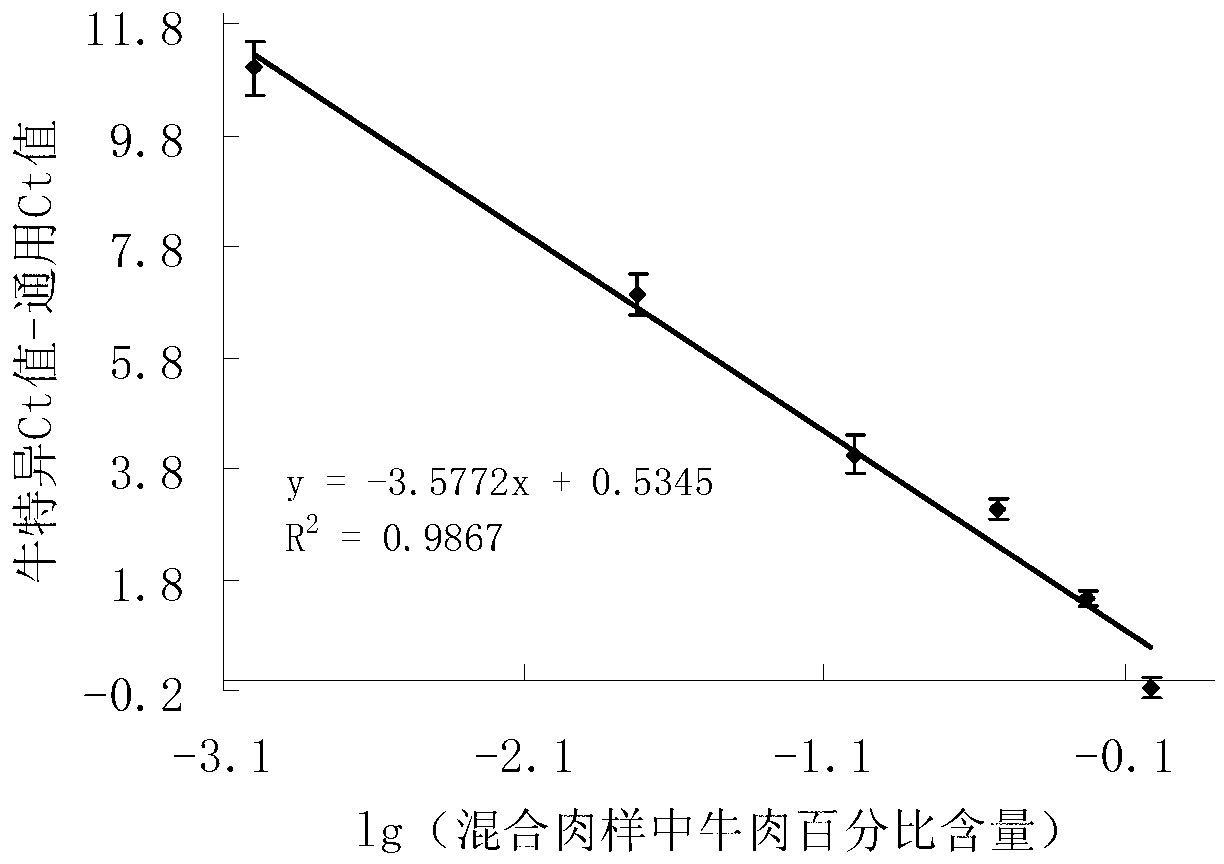Method for detecting bovine-derived materials in meat and meat products
A cattle-derived, meat product technology, applied in DNA/RNA fragmentation, recombinant DNA technology, etc., can solve the difficulty of standard sample selection and preparation, the research lag of quantitative detection technology of nucleic acid components, the total amount of DNA extracted and the amplification target Problems such as the difference in the total amount of sequence templates
- Summary
- Abstract
- Description
- Claims
- Application Information
AI Technical Summary
Problems solved by technology
Method used
Image
Examples
Embodiment 1
[0098] Embodiment 1 bovine specific primer of the present invention, the specificity of probe system
[0099] 1. Primer and probe sequence
[0100] Bovine-specific oligonucleotide primers and probes,
[0101] Upstream primer: 5'-ATCTGAATCAATGCAACAGTACAT-3';
[0102] Downstream primer: 5'-TGATAGTGAGTCGGAGAAGAATGT-3';
[0103] Probe: 5'-FAM-TCTCCTCATTAGCCTGATCAGTCTATCCC-TAMRA-3'.
[0104] 2. Sample processing method
[0105] Weigh 0.2g of 13 common meat samples of pig, cattle, sheep, chicken, duck, donkey, rabbit, deer, dog and fish into 1.5ml centrifuge tubes.
[0106] 3. DNA extraction method
[0107] Add 800 μL of lysate to the 1.5ml centrifuge tube from which the sample was taken in step 2, and incubate at 65°C for 30 minutes, shaking and mixing from time to time. Centrifuge at 12000g for 5min, transfer 600μL supernatant to a clean centrifuge tube, add 400μL CTAB protein sedimentation solution, shake and mix well, centrifuge at 12000g for 5min, take 400μL supernatant i...
Embodiment 2
[0119] Embodiment 2 The linear relationship of detection method system of the present invention
[0120] 1. Primer and probe sequence
[0121] Bovine-specific oligonucleotide primers and probes,
[0122] The upstream primer is: 5'-AATATAATTTGGGTTAACTCCACAGC-3';
[0123] The downstream primer is: 5'-GCCATATGGTTAAAATTAGTAGTGGAGTG-3';
[0124] The probe is: 5'-FAM-CACAGCCTTCTAATTAGCTTTACAAGCCTCC–TAMRA-3'.
[0125] Vertebrate Universal Oligonucleotide Primers and Probes
[0126] Upstream primer: 5'-TACGACCTCGATGTTGGATCA-3';
[0127] Downstream primer: 5'-AGATAGAAACCGACCTGGAT-3';
[0128] Probe: 5'-FAM-CCGGTCTGAACTCAGATCACGTAGGA-TAMRA-3' (for singleplex PCR);
[0129] Probe: 5'-HEX-CCGGTCTGAACTCAGATCACGTAGGA-TAMRA-3' (for duplex PCR);
[0130] 2. Processing of pure beef samples and preparation of beef / sheep / pig mixed meat samples containing series of concentrations of beef
[0131] Weigh 30g of beef, mutton and pork respectively into 3 clean homogenization cups, add 120g of...
Embodiment 3
[0149] Embodiment 3 The accuracy and precision of detection method system of the present invention
[0150] 1. Preparation of samples to be tested
[0151] Weigh 30g of beef, mutton, pork, chicken and duck into 5 clean homogenization cups, add 120g of deionized double-distilled water, and homogenize at 12000r / min for 8min to obtain 5 homogenates. Use an analytical balance (accurate to 0.0001g) to accurately weigh each homogenate according to the proportions in Table 6, and obtain beef contents of 0.1%, 1.9%, 10.0%, 30.0%, 60.0%, 98.0%, 5.83%, 32.27%, 42.87%, 22.33% beef / sheep / pig mixed meat samples 3g were placed in 5ml centrifuge tubes, each group of samples was set up in three parallels, vortexed for 1min, and 50μl homogenate was pipetted into 1.5ml centrifuge with a 100μl micropipette tube, pending further processing.
[0152] Table 8 The ratio of each component of the mixed sample
[0153] Sample serial number
Cattle
sheep
pig
chicken
d...
PUM
 Login to View More
Login to View More Abstract
Description
Claims
Application Information
 Login to View More
Login to View More - R&D
- Intellectual Property
- Life Sciences
- Materials
- Tech Scout
- Unparalleled Data Quality
- Higher Quality Content
- 60% Fewer Hallucinations
Browse by: Latest US Patents, China's latest patents, Technical Efficacy Thesaurus, Application Domain, Technology Topic, Popular Technical Reports.
© 2025 PatSnap. All rights reserved.Legal|Privacy policy|Modern Slavery Act Transparency Statement|Sitemap|About US| Contact US: help@patsnap.com



